+Search query
-Structure paper
| Title | A structural dendrogram of the actinobacteriophage major capsid proteins provides important structural insights into the evolution of capsid stability. |
|---|---|
| Journal, issue, pages | Structure, Vol. 31, Issue 3, Page 282-294.e5, Year 2023 |
| Publish date | Mar 2, 2023 |
 Authors Authors | Jennifer M Podgorski / Krista Freeman / Sophia Gosselin / Alexis Huet / James F Conway / Mary Bird / John Grecco / Shreya Patel / Deborah Jacobs-Sera / Graham Hatfull / Johann Peter Gogarten / Janne Ravantti / Simon J White /   |
| PubMed Abstract | Many double-stranded DNA viruses, including tailed bacteriophages (phages) and herpesviruses, use the HK97-fold in their major capsid protein to make the capsomers of the icosahedral viral capsid. ...Many double-stranded DNA viruses, including tailed bacteriophages (phages) and herpesviruses, use the HK97-fold in their major capsid protein to make the capsomers of the icosahedral viral capsid. After the genome packaging at near-crystalline densities, the capsid is subjected to a major expansion and stabilization step that allows it to withstand environmental stresses and internal high pressure. Several different mechanisms for stabilizing the capsid have been structurally characterized, but how these mechanisms have evolved is still not understood. Using cryo-EM structure determination of 10 capsids, structural comparisons, phylogenetic analyses, and Alphafold predictions, we have constructed a detailed structural dendrogram describing the evolution of capsid structural stability within the actinobacteriophages. We show that the actinobacteriophage major capsid proteins can be classified into 15 groups based upon their HK97-fold. |
 External links External links |  Structure / Structure /  PubMed:36649709 / PubMed:36649709 /  PubMed Central PubMed Central |
| Methods | EM (single particle) |
| Resolution | 2.2 - 4.0 Å |
| Structure data | EMDB-27824, PDB-8e16: EMDB-27992, PDB-8eb4: EMDB-28012, PDB-8ec2: EMDB-28015, PDB-8ec8: EMDB-28016, PDB-8eci: EMDB-28017, PDB-8ecj: EMDB-28018, PDB-8eck: EMDB-28020, PDB-8ecn: EMDB-28021, PDB-8eco: EMDB-28039, PDB-8edu: |
| Source |
|
 Keywords Keywords | VIRUS / HK97-fold / T=9 / tailed bacteriophage / T=7 / Bacteriophage / Mycobacteriophage / Capsid |
 Movie
Movie Controller
Controller Structure viewers
Structure viewers About Yorodumi Papers
About Yorodumi Papers






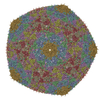

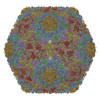

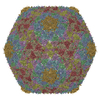

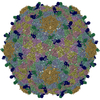

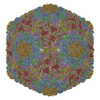

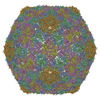

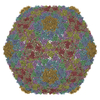

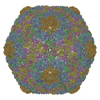

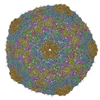
 mycobacterium virus che8
mycobacterium virus che8